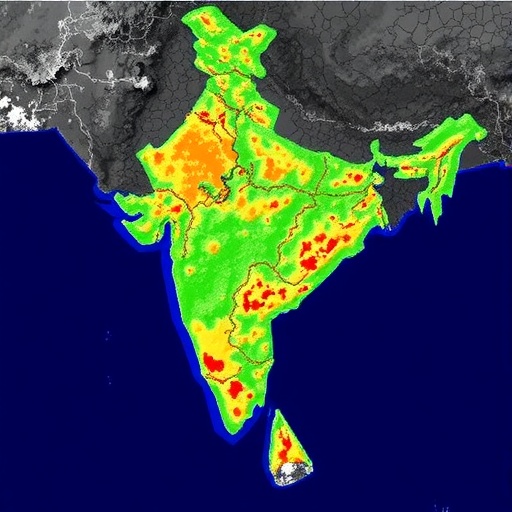In an era where climate change relentlessly challenges ecosystems worldwide, the intersection of cutting-edge analytics and environmental science presents new avenues for understanding and mitigating these impacts. A groundbreaking study led by Paul, Reddy, Kumar, and colleagues pushes the frontier in this domain by meticulously mapping and assessing abiotic stresses in the hot semi-arid ecosystems of western India. This innovative research integrates the Analytical Hierarchy Process (AHP) with sophisticated machine learning models to offer an unprecedented spatial and temporal evaluation of environmental stressors, signaling a transformative step forward in ecosystem management and resilience planning.
The hot semi-arid landscape of western India, characterized by high temperatures, erratic rainfall, and fragile soils, represents a critical but vulnerable ecosystem. Abiotic stresses—non-living environmental factors like drought, soil salinity, and extreme temperature fluctuations—pose substantial threats to biodiversity, agricultural productivity, and the livelihood of millions. Understanding these stressors’ distribution and intensity is paramount for designing adaptive strategies that can safeguard ecological and socio-economic stability in the region.
Leveraging the Analytical Hierarchy Process, a multi-criteria decision-making tool, the researchers systematically distilled complex environmental data into weighted indices reflecting the relative importance of various stress factors. AHP’s strength lies in its capability to incorporate expert judgment alongside quantitative indicators, thereby producing a nuanced prioritization of abiotic stresses tailored to the semi-arid context. This approach facilitates an evidence-based framework that reflects ground realities, grounding machine learning predictions in well-substantiated parameters.
Complementing the AHP method, the study employs advanced machine learning algorithms to analyze extensive datasets encompassing climatic variables, soil properties, topography, and land use patterns. These models excel at capturing nonlinear relationships and interactions inherent to ecological systems, allowing for highly accurate spatial mapping of abiotic stress distributions. Such machine learning applications mark a paradigm shift from traditional statistical methods, providing scalable and replicable tools suitable for dynamic environmental monitoring.
Importantly, the integration of AHP and machine learning models exemplifies a hybrid analytical strategy that enhances predictive accuracy while maintaining interpretability. Machine learning models, often critiqued for their “black box” nature, benefit from the hierarchical input framework of AHP, yielding outputs that policymakers and environmental managers can readily comprehend and act upon. Consequently, this methodology sets a benchmark for future ecological assessments within semi-arid zones and beyond.
The study’s spatial analysis reveals hotspots of abiotic stress aligned with regions exhibiting low vegetation cover, deteriorated soil quality, and limited water availability. These zones correlate strongly with declining agricultural yields and heightened vulnerability among local communities. Such insights underscore the urgency of targeted interventions, prioritizing resource allocation to areas facing the most severe stress loads and potential ecosystem collapse.
By employing satellite remote sensing data alongside ground-truthing campaigns, the researchers ensured that model predictions were robust and validated against empirical observations. This dual-pronged data acquisition strategy not only strengthens the credibility of findings but also establishes a replicable workflow for ongoing environmental surveillance. As semi-arid regions globally confront intensifying climatic pressures, the adaptability of this approach holds significant promise.
Moreover, the implications of this research extend beyond immediate environmental monitoring. The quantified mapping of abiotic stresses informs sustainable land management policies, aids in the restoration of degraded landscapes, and guides climate-smart agricultural practices that enhance resilience. In a socio-ecological context, these advances contribute to safeguarding food security and the socio-economic well-being of rural populations reliant on fragile ecosystems.
From a technological perspective, this study navigates the complexities of handling heterogeneous environmental data, overcoming challenges related to data sparsity and noise through ensemble machine learning techniques and rigorous cross-validation. This meticulous attention to methodological rigor ensures that the final stress maps are not only scientifically robust but also operationally feasible for integration into regional planning tools.
The researchers also emphasize the dynamic nature of abiotic stresses under climate change scenarios. By simulating future trajectories using climate model projections, they illustrate potential shifts in stress patterns, identifying emerging risk zones that may require proactive adaptation strategies. This forward-looking element is crucial for constructing resilient landscapes capable of withstanding escalating environmental uncertainties.
Notably, the framework developed in this study encourages participatory approaches by enabling local stakeholders, including farmers and resource managers, to engage with accessible stress maps and decision-support tools. Such inclusivity fosters community empowerment, catalyzes localized innovation, and ensures that ecosystem management is both scientifically informed and socially equitable.
While the technological advancements showcased are impressive, the authors acknowledge ongoing limitations, including the need for finer-resolution datasets and integration of biotic stressors that interact with abiotic factors. Future iterations of this research aim to incorporate real-time sensor networks and artificial intelligence-driven adaptive learning models to refine predictive capacities continuously.
In conclusion, this pioneering work stands as a testament to the power of interdisciplinary collaboration harnessing environmental science, decision analysis, and artificial intelligence. By unveiling the spatial complexity of abiotic stresses in one of the world’s most vulnerable ecosystems, it pioneers a scalable and replicable model for global application. As climate risks mount, such innovative methodologies illuminate pathways toward ecological stewardship and sustainable development in semi-arid landscapes and beyond, offering hope and concrete tools for a more resilient future.
—
Subject of Research: Mapping and assessment of abiotic stresses in hot semi-arid ecosystems using advanced analytical and machine learning techniques.
Article Title: Mapping and assessment of abiotic stresses in hot semi-arid ecosystem of western India using analytical hierarchy process and machine learning models.
Article References:
Paul, N.C., Reddy, G.P.O., Kumar, N. et al. Mapping and assessment of abiotic stresses in hot semi-arid ecosystem of western India using analytical hierarchy process and machine learning models.
Environ Earth Sci 84, 276 (2025). https://doi.org/10.1007/s12665-025-12272-7
Image Credits: AI Generated




